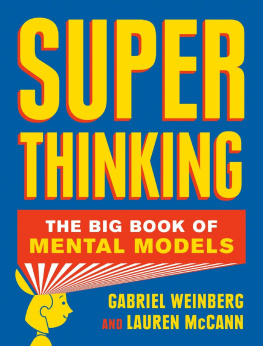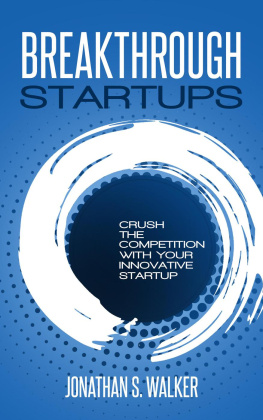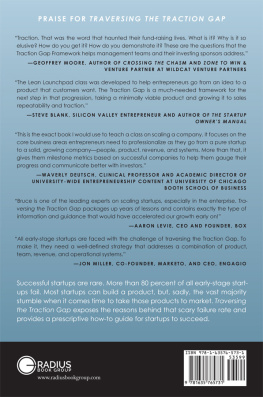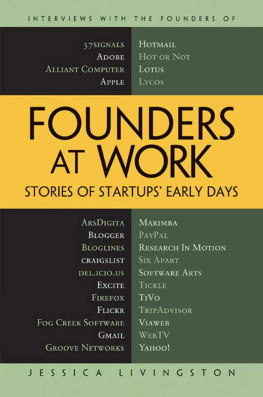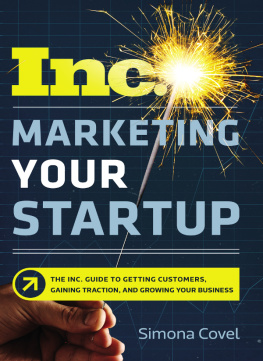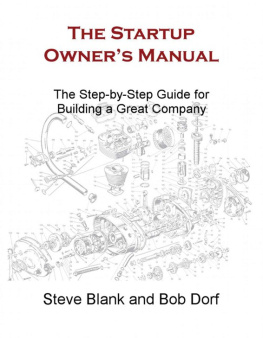Prologue Traction Trumps Everything
Building a successful company is hard. Really hard. Weve been involved in both startup successes and startup failures.
Who are we? Gabriel is currently the CEO and founder of DuckDuckGo, an alternative search engine he started in 2008 that received over a billion searches in 2013 and is growing rapidly. In 2006, he sold his last company, Opobox, for ten million. Gabriel is also an active angel investor, having invested in over ten early stage ventures with two successful exits so far.
Justin founded two startups (one of which was acquired) and recently ran growth at Exceptional Cloud Services, which was acquired by Rackspace in 2013.
Traction is the best way to improve your chances of startup success. Traction is a sign that something is working. If you charge for your product, it means customers are buying. If your product is free, its a growing userbase.
Traction is powerful. Technical, market, and team risks are easier to address with traction. Fundraising, hiring, press, partnerships and acquisitions are all easier with traction.
In other words, traction trumps everything .
This book is for startups of all kinds: consumer or enterprise-focused, from ecommerce to apps and everything in between.
Weve interviewed more than forty founders, studied many more companies, and pulled out the repeatable strategies and tactics they used to succeed.
Our goal is to show you how to get traction no matter what business youre in.
1 Traction Channels
Before we get started, lets define what traction is. Traction is a sign that your company is taking off. Its obvious in your core metrics: if you have a mobile app, your download rate is growing rapidly. If youre a search engine, your number of searches is skyrocketing. If a SaaS tool, your monthly revenue is blowing up. If a consumer app, your daily active users are increasing quickly. You get the point.
Naval Ravikant, founder of AngelList, an online platform that helps companies raise money, says it well:
Traction is basically quantitative evidence of customer demand. So if youre in enterprise software, [initial traction] may be two or three early customers who are paying a bit; if youre in consumer software the bar might be as high as hundreds of thousands of users. Its the Supreme Court definition of porn. Youll know it when you see it.
You can always get more traction. The whole point of a startup is to grow rapidly. Getting traction means moving your growth curve up and to the right as best you can. Paul Graham, founder of startup accelerator Y Combinator, puts it like this:
A startup is a company designed to grow fast. Being newly founded does not in itself make a company a startup. Nor is it necessary for a startup to work on technology, or take venture funding, or have some sort of exit. The only essential thing is growth. Everything else we associate with startups follows from growth.
In other words, traction is growth. The pursuit of traction is what defines a startup .
Nineteen Traction Channels
After interviewing more than forty successful founders and researching countless more, we discovered that startups get traction through nineteen different channels . Many successful startups experimented with multiple channels (search engine marketing, business development, etc.) until they found one that worked.
We call these customer acquisition channels traction channels . These are marketing and distribution channels through which your startup can get traction: real users and customers.
We discovered two broad themes through our research:
- Most founders only consider using traction channels theyre already familiar with or think they should be using because of their type of product or company. This means that far too many startups focus on the same channels (search engine marketing, public relations) and ignore other promising ways to get traction.
- Its hard to predict the channel that will work best. You can make educated guesses, but until you start running tests, its difficult to tell which channel is the best one for you right now .
Our introductory chapters 25 expand on these themes. Chapter 2 introduces our Bullseye Framework for getting traction. Essentially, it involves targeted experimentation with a few traction channels, followed by laser focus on the one that is working.
Chapters 3 and 4 offer traction strategies and tactics to apply when using Bullseye, including pursuing traction development in parallel with product development. Chapter 5 offers one way to approach parallel traction/product development called the Critical Path where you focus on a single traction goal and ignore everything not required to achieve it.
Before you jump into this material, however, wed like to introduce you to the nineteen traction channels and some of the people we interviewed for them. We will explore each of these channels in chapters 624.
When going through these traction channels try your best not to dismiss them as irrelevant for your company. Each traction channel has worked for startups of all kinds and in all different stages . Get one channel working that your competitors dismiss, and you can grow rapidly while they languish.
Viral Marketing (Chapter 6 )
Viral marketing consists of growing your userbase by encouraging your users to refer other users. We interviewed Andrew Chen, a viral marketing expert and mentor at 500 Startups, for common viral techniques and the factors that have led to viral adoption in major startups. We also talked with Ashish Kundra of myZamana, who discussed using viral marketing to grow from 100k users to over 4 million in less than a year.
Public Relations (Chapter 7)
Public relations (PR) is the art of getting your name out there via traditional media outlets like newspapers, magazines and TV. We interviewed Jason Kincaid, former TechCrunch writer, about pitching media outlets, how to form relationships with reporters, and what most startups do wrong when it comes to PR. We also talked with Ryan Holiday, bestselling author of Trust Me, Im Lying and media strategist, to learn how startups could leverage todays rapidly changing media landscape to get traction.
Unconventional PR (Chapter 8)
Unconventional PR involves doing something exceptional (like publicity stunts) to draw media attention. This channel can also work by repeatedly going above and beyond for your customers. Alexis Ohanian told us some of the things he did to get (and keep) people talking about reddit and Hipmunk, two startups he co-founded.
Search Engine Marketing (Chapter 9)
Search engine marketing (SEM) allows companies to advertise to consumers searching on Google and other search engines. We interviewed Matthew Monahan of Inflection, the company behind Archives.com (before its $100 million acquisition by Ancestry.com) to learn how Archives relied primarily on SEM for their growth.
Social and Display Ads (Chapter 10)
Ads on popular sites like reddit, YouTube, Facebook, Twitter and hundreds of other niche sites can be a powerful and scalable way to reach new customers. We brought in Nikhil Sethi, founder of the social ad buying platform Adaptly, to talk with us about getting traction with social and display ads.
Offline Ads (Chapter 11)
Offline ads include TV spots, radio commercials, billboards, infomercials, newspaper and magazine ads, as well as flyers and other local advertisements. These ads reach demographics that are harder to target online, like seniors, less tech-savvy consumers and commuters. Few startups use this channel, which means theres less competition for many of these audiences. We talked with Jason Cohen, founder of WPEngine and Smart Bear Software, about the offline ads hes used to acquire customers.


